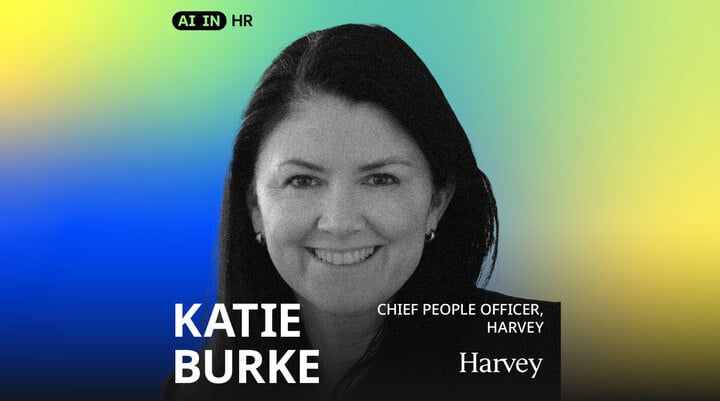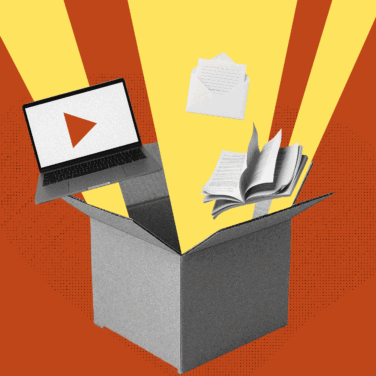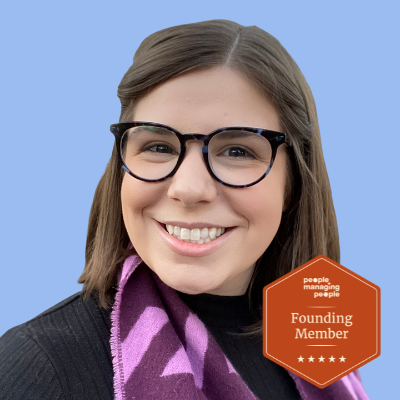AI Impact: AI shifts focus from headcount planning to efficiency and transformation in a work-first approach.
Tech Stack: Harvey utilizes an AI-centric tech stack to streamline operations and enhance internal efficiency.
Leadership Role: Successful AI adoption starts with leadership, ensuring senior executives integrate AI into strategies.
Flexible Planning: Adapting to rapid AI advancements requires a flexible, agile approach to organizational planning.
AI Literacy: Cultivating AI literacy within an organization involves education, sharing, and practical applications.
Katie Burke is the Chief People Officer at Harvey, an AI company changing how work is done in the legal and professional services world. Before that, she was CPO at HubSpot — so handling People teams in hyper-growth environments is what she does best.
We sat down with Katie to understand how she is leveraging AI to do exactly that. Here's what she had to say.
From CPO of Hubspot to Running the “Glue” Team at Harvey
I'm the Chief People Officer at Harvey. I run what we call internally the "glue" team, which includes recruiting, HR, marketing, business technology, and customer engagement.
Harvey is AI for the legal and professional services world, and I've been here for about a year. Before that, I was the Chief People Officer at HubSpot and spent almost twelve years there. During that time, HubSpot was lucky enough to be recognized globally for our culture.
I'm a slightly unconventional people leader because I started my career in marketing, so now, I get to do a little bit of both. Leadership-wise, the common denominator in all the organizations I've worked for is a fast pace — I thrive in a world where you get to add a little bit of structure and process to companies and teams in hyper-growth.
In the People space, the biggest fundamental change in an AI-first world is shifting the framing of “headcount planning” to “work to be done” and rethinking the units to get there. It’s no longer a question of what combination of full-time, contract, and agency work will get this scope done; it’s more about what work is getting done by humans, where we see efficiencies with AI, and what functions will fundamentally transform in the new model.
Why Headcount Planning Is Changing in an Ai-First World — and How to Adapt
In the People space, the biggest fundamental change in an AI-first world is shifting the framing of "headcount planning" to "work to be done" and rethinking the units to get there. It's no longer a question of what combination of full-time, contract, and agency work will get this scope done; it's more about what work is getting done by humans, where we see efficiencies with AI, and what functions will fundamentally transform in the new model.
To that end, part of our job is helping the organization be realistic about when adoption provides modest improvements in efficiency — and when we'll see fundamental changes in staffing needed.
I think the time horizon issue is probably the hardest one to get right. You've got to be realistic and predict based on model performance, iteration, and organizational adoption of AI, since it's predicated on all three factors.
Ten years ago, I would typically outline a three-year headcount plan. Of course, I would adapt it throughout the year and adjust things as needed at regular intervals — but the point is that it was feasible to do a rough SWAG at headcount planning three years out. Whereas now, I think everyone is making headcount planning more agile,
At Harvey, we currently work with finance on a rough one-year plan, but realistically, most of the hard work is done at quarterly intervals. And we see the same shift in our customers. They used to plan three years out, but now adjust plans more regularly.
Most organizations build an assumption of productivity and efficiency with AI into their approaches. But it's harder to realistically assess not just where they will see efficiency gains, but also where full teams or business needs will shift entirely due to AI.
So, my recommendation is to build flexibility into your overall approach, and to take a much more agile approach to planning across your organization. That way you benefit from the major improvements reflected in the technology, but you don't end up way behind on your hiring or business needs.
My recommendation is to build flexibility into your overall approach, and to take a much more agile approach to planning across your organization. That way you benefit from the major improvements reflected in the technology, but you don’t end up way behind on your hiring or business needs.
Inside Harvey’s Internal AI Tech Stack for Scaling Operations
Here's our internal tech stack at Harvey:
- Google Workplace as a online collaboration tool for emails, etc.
- Slack as a internal communication tool
- Zoom for meetings
- Notion as a project management tool for documentation
- Ashby for recruiting
- Glean for searching documents and as a workforce management software
- AIR for identifying and tagging brand assets
- Tenor as a performance management software for check-ins
- Harvey for translation, deep research, drafting, and storing critical documents as a document management system
We are in the process of adding a few additional AI-specific tools to our stack as we speak. And because we are a multi-model company, we use Gemini, Claude, and ChatGPT — both on their own and to test out Harvey outputs via our Legal Research team.
And our recruiting team is doing a lot of experimentation to sort out their future-state tech stack for next year — more to come from us on how we innovate in that space.
Real-World AI Workflows That Save Time and Scale Teams in Hyper-Growth
One of my favorite workflows, which relies on a combination of automation and AI, helps close out our internal Slack channels that we use for internal collaboration when a candidate officially signs their offer letter in Ashby.
That event sets off a few different events, including putting their start date on their manager's calendar, letting IT know of the candidate, location, and start date, and automating some of the candidate workflows to help them onboard. It makes something we do very often — hiring in hyper-growth — notably easier to scale globally.
Here are a few more examples of ways we're using our internal tech stack:
Our biggest change has been adding Glean to our stack. We are growing super fast at Harvey so the ability for employees to quickly search Slack and Google Docs for that one thing they need in a manner of seconds was paramount. It has been a massive time saver.
- Glean: Our biggest change has been adding Glean to our stack. We did a mini rollout to ensure the use case worked for us and saved us time. We are growing super fast at Harvey, so the ability for employees to quickly search Slack and Google Docs for that one thing they need in a matter of seconds was paramount. It has been a massive time saver. Personally, I've already noticed a big difference searching for files across teams and locations, or trying to get context on something quickly without bothering someone in a meeting.
- Slack: Our VP of marketing set up a custom GPT for drafting leader communications so that we learn from past iterations in drafting future ones. We save hours on first drafts across our team.
- Tenor: We are currently in the midst of performance check-ins and use a tool called Tenor to help prep for feedback conversations. You can upload context and practice live to get feedback in real-time, which makes for better check-ins and, ideally, better feedback for your team.
- AIR: AIR has been incredibly helpful for fast identification and tagging of our internal brand assets.
- Harvey: We use our own Harvey platform for translation, deep research, drafting, and also storing critical documents to make it easier to query and access them in a secure manner. Our Vault feature has been helpful for things like sourcing how many of our customer contracts are renewed on X date or how many employee agreements have Y provision. It saves our team and the legal team hours if not days each month. Similarly, on decision making, I often use Harvey to learn what dissenting arguments people might have about a given change before we roll it out. If it's good enough for litigators, it can certainly make internal change management processes more impactful before we send them out!
The right question isn't, "Where can you add AI to existing processes?" It's, "How can you rethink current processes to make work notably easier?"
The right question isn't, "Where can you add AI to existing processes?" It's, How can you rethink current processes to make work notably easier?
How to Improve AI Literacy Across an Organization
AI literacy is slightly different for us, because Harvey is an AI company, so we tend to spend a lot of time in the interview process focused on folks who have a certain level of AI literacy, comfort, and interest. But it's worth noting that a few of the ways we increase AI literacy internally are the same as we recommend to our customers:
- We have breakfasts hosted by our AI research team, where we focus on AI. It's explicitly stated you don't have to be an expert to attend and come learn in a low-pressure setting.
- We have lawyers on our team called Strategic Business Development Specialists and Legal Product Specialists — they host deep dives on practice areas or geographies with specific examples of how best to use Harvey in their areas of expertise. They have also been kind enough to do lunch-and-learns for our recruiting team and our executive operations team so both of those organizations get better context on how they can use Harvey to make their jobs easier.
- We'll have folks share the specific prompt they used to deliver an output — last week, our CEO shared with me one he used for Deep Research and our VP of Product shared one that his Product Operations team used to handle internal queries within our knowledge management system. Normalizing sharing what works definitely helps, and also normalizes asking for help if you need it.
Lessons Learned About AI Adoption in Fast-Growing Companies
Why AI Adoption Must Start With Leadership
There's a perception that AI is most used or most effective with junior people. That's not what I'm seeing.
About 20% of the folks who use Harvey weekly are partners, and it's becoming increasingly clear that organizations that prioritize senior folks leaning into AI and building it into their operating system as an organization are by far more successful than folks who attempt incremental change or depend on bottom-up adoption.
If you're rolling out AI tools, take the time to get your leadership team on board first, or in parallel with the rest of the organization. AI success is as much about great change management in practice as it is about technology.
Why Leaders Should Inspire AI Adoption With the Carrot, Not the Stick
Make sure you're thinking more carrot than stick. I'm a big believer that the most successful organizations are showing what's possible with AI by delivering results and leading from the front, versus over-indexing on fear. You, as a leader in the people organization, have a responsibility to lean into that change.
Why Creating “Aha” Moments Is Key to Successful AI Adoption
Right now, one of the biggest challenges with AI adoption is getting people to their first "aha" moment. This is true internally, and we also see it when we roll out Harvey in organizations. Employees need to get to a moment where the realization is not, "AI is cool," but rather, "Here's how AI can help me do my job better."
Right now, one of the biggest challenges with AI adoption is getting people to their first "aha" moment.
That means helping people identify use cases that are relevant to their specific practice areas and geographies. Once you have that moment of impact, it's a lot easier to build comfort around trying new things.
Why Organizations Must Move Beyond Fear Narratives Around AI
Equally critical is ensuring we move past the narrative of fear.
A lot of people are afraid to try AI because they are worried about job replacement. I think we need to do a better job noting how AI can meaningfully help improve people's jobs. We need to create space for more training and more mentorship.
A lot of people are afraid to try AI because they are worried about job replacement. I think we need to do a better job noting how AI can meaningfully help improve people’s jobs. We need to create space for more training and more mentorship.
I've seen a few examples that really help with this:
- Creating places for people to learn the basics of prompting and seeing use cases that can help them in their specific roles.
- Making the training more fun and engaging than mandatory and archaic. The most successful implementations we see typically feature making the rollout of Harvey feel relevant to the entire organization with buy-in from leadership.
- Creating a culture of experimentation. It's important to normalize that trying things out is the goal; not getting it perfect on the first try.
- Using reverse mentorship. I often learn better prompts or use cases from our younger employees, and I'm very grateful for that.
Avoid Incremental Approaches to AI Adoption
And finally, resist the temptation for incrementalism in your approach to AI adoption.
How AI Can Restore Meaning and Purpose to Our Work
I actually don't love making bold predictions — I don't think I'm particularly good at it. However, I like picking founders who make bold predictions, and I've had some reasonable success with that, so instead, I'll share one of the core beliefs Harvey is built on thanks to our founders.
They believe that done well, AI should bring us back to what most careers should be: more time for apprenticeship, mentorship, and learning on the job versus an endless stream of work, revisions, and workstreams where you don't feel like you're adding a ton of value.
So my hope is that over time, AI gives us more time back to add meaning to our jobs and to feel more fulfilled in our daily work.
My hope is that over time, AI gives us more time back to add meaning to our jobs and to feel more fulfilled in our daily work.
Follow Along
You can follow Katie as she changes the way teams operate in high-growth environments on X and LinkedIn. And check out Harvey — AI for the legal and professional services world.
More expert interviews to come on People Managing People!






